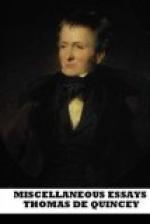from his human functions, passed rapidly into
a further development, no longer gay or playful, but
terrific, the most terrific that besieges dreams,
viz—the horrid inoculation upon each other
of incompatible natures. This horror has always
been secretly felt by man; it was felt even under
pagan forms of religion, which offered a very feeble,
and also a very limited gamut for giving expression
to the human capacities of sublimity or of horror.
We read it in the fearful composition of the sphinx.
The dragon, again, is the snake inoculated upon the
scorpion. The basilisk unites the mysterious malice
of the evil eye, unintentional on the part of the
unhappy agent, with the intentional venom of some
other malignant natures. But these horrid complexities
of evil agency are but objectively horrid;
they inflict the horror suitable to their compound
nature; but there is no insinuation that they feel
that horror. Heraldry is so full of these fantastic
creatures, that, in some zoologies, we find a separate
chapter or a supplement dedicated to what is denominated
heraldic zoology. And why not? For these
hideous creatures, however visionary[8], have a real
traditionary ground in medieval belief—sincere
and partly reasonable, though adulterating with mendacity,
blundering, credulity, and intense superstition.
But the dream-horror which I speak of is far more
frightful. The dreamer finds housed within himself—occupying,
as it were, some separate chamber in his brain—holding,
perhaps, from that station a secret and detestable
commerce with his own heart—some horrid
alien nature. What if it were his own nature
repeated,—still, if the duality were distinctly
perceptible, even that—even this
mere numerical double of his own consciousness—might
be a curse too mighty to be sustained. But how,
if the alien nature contradicts his own, fights with
it, perplexes, and confounds it? How, again,
if not one alien nature, but two, but three, but four,
but five, are introduced within what once he thought
the inviolable sanctuary of himself? These, however,
are horrors from the kingdoms of anarchy and darkness,
which, by their very intensity, challenge the sanctity
of concealment, and gloomily retire from exposition.
Yet it was necessary to mention them, because the
first introduction to such appearances (whether causal,
or merely casual) lay in the heraldic monsters, (which
monsters were themselves introduced though playfully,)
by the transfigured coachman of the Bath mail.




